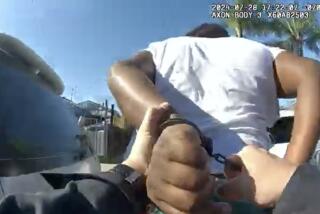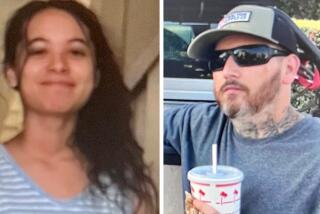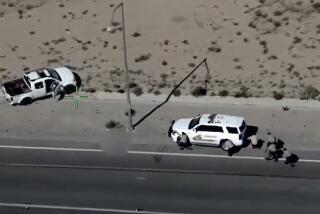Man who recorded Walter Scott shooting says his life has changed forever
Reporting from North Charleston, S.C. — If not for a chilling cellphone video, the shooting of Walter Scott in North Charleston, S.C., might have been written off as a justified police shooting, another case of an officer gunning down a man because he feared for his life.
That was certainly what family members, who doubted the initial police account, had feared until a young man, Feidin Santana, approached the victim’s brother Sunday afternoon. He was standing in the exact spot where Scott had been killed a day earlier.
“I have something to share with you,” Santana said, according to Anthony Scott.
Santana had used his Samsung cellphone to record the chilling video that has now been viewed around the world. It shows Walter Scott running away from Michael Thomas Slager as the now former North Charleston police officer unleashed a volley of gunfire that felled the 50-year-old.
Slager was charged with murder Tuesday, but in the immediate aftermath of that announcement, little was known about the young man who is largely responsible for his arrest.
Santana was initially hesitant to come forward. He told NBC that he was so worried about repercussions that he considered erasing the video and leaving town.
He decided to act after concluding that Slager’s confrontation with Scott was being misrepresented. “I saw the police report, and I saw it was going the wrong way …. I got mad,” he said. The official description of what happened “wasn’t like I saw it.”
So, he said, he approached police and told them he had witnessed the shooting and had video, but then his fear won out. “I just ran out of there,” he said.
He said he ultimately brought the clip to Scott’s relatives after realizing that if the same thing had happened to one of his family members, he “would like to know the truth.”
Santana’s initial fears about retribution may not have been unwarranted. This video is the latest in a series of unsettling clips that have depicted police officers killing or injuring unarmed black men in recent years. People behind those cameras have lived to regret the attention, and sometimes danger, that came with involving themselves in such high-profile cases.
Before the North Charleston shooting, a cellphone video of Staten Island, N.Y., resident Eric Garner pleading, “I can’t breathe,” after he was wrestled to the ground was one of the most jarring clips tied to recent allegations of police brutality.
The man who recorded the fatal clash, 22-year-old Ramsey Orta, told the Los Angeles Times last year that he took the video and made it public because he was furious with officers’ treatment of Garner, whom he described as a friendly presence in the neighborhood where he died.
Garner’s death was ruled a homicide by the New York City medical examiner’s office, which determined that the officers’ actions contributed to this death. Many have contended NYPD Officer Daniel Pantaleo used a chokehold, an outlawed police tactic that has been tied to deaths nationwide, to bring down Garner.
Although Orta gave several media interviews in the immediate aftermath of Garner’s death, he retreated from public view after he was arrested in August on weapons charges. New York police allege he was carrying a stolen semiautomatic handgun, but Orta has contended the arrest was retribution for his decision to make the Garner video public, according to the Staten Island Advance.
A person who answered Orta’s cellphone Wednesday declined to comment.
George Holliday, the Los Angeles man who recorded the beating of Rodney King by four LAPD officers in 1991 after being awakened by sirens, has sometimes wondered whether he would have been better off staying in bed the night of the incident.
In a 2006 interview with the Times, Holliday said he received death threats when riots followed the officers’ acquittal.
“Be careful when you start your car in the morning,” read one note Holliday received in the early 1990s, he said. Sometimes, when people recognized him as the man behind the King video, Holliday said, they called him “the guy who caused the riots.”
Holliday has also said the media attention he got because of the video helped lead to the collapse of his marriage.
Not everyone responsible for recordings of recent controversial police clashes has found themselves crushed by the resulting scrutiny. Anthony Blackburn, the man who filmed the fatal police shooting of a homeless man along Los Angeles’ skid row last month, has offered only a few interviews, including one where he questioned police officer’s actions when speaking to CNN.
Blackburn asked why the officers involved in the shooting didn’t simply aim for the man’s leg.
“He’s already on the ground,” Blackburn said, according to the CNN report.
------------
FOR THE RECORD
April 9, 3:01 p.m.: An earlier version of this story mistakenly quoted Anthony Blackburn as defending the actions of LAPD officers involved in the fatal shooting of Charly Leundeu Keunang on March 1 in Skid Row. The quote previously referred to in the CNN report was actually given by Los Angeles Police Chief Charlie Beck. The quote has been removed from the story.
------------
The person who made a similarly unnerving video of police shooting a homeless man in the back in Pasco, Wash., in February has remained unidentified despite national interest in the incident.
After Santana revealed himself on Wednesday, he said his life has changed forever.
“I never thought this would happen, that I would be a witness,” he said in an interview on NBC’s “Today” show. “I’m still scared.”
Queally reported from Los Angeles and Zucchino from North Charleston. Times staff writers Kurtis Lee and Lauren Raab in Los Angeles contributed to this report.
Follow @JamesQueallyLAT for breaking news
More to Read
Sign up for Essential California
The most important California stories and recommendations in your inbox every morning.
You may occasionally receive promotional content from the Los Angeles Times.












